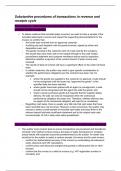Summary
Summary Revenue and Receipts cycle substantive procedures
- Course
- The Audit Process (AUE3761)
- Institution
- University Of South Africa (Unisa)
The document contains information on how to formulate substantive procedures for the revenue and receipts process(including trade receivables)
[Show more]



